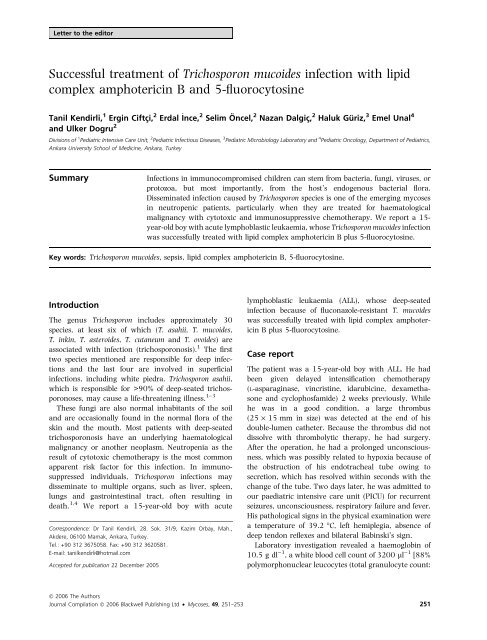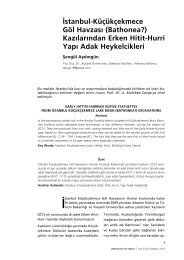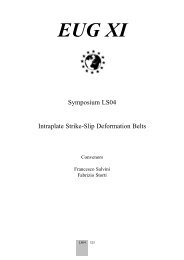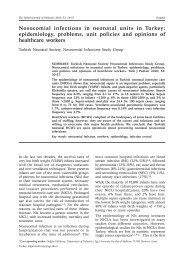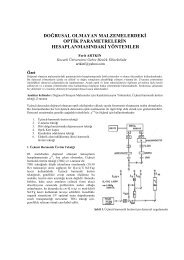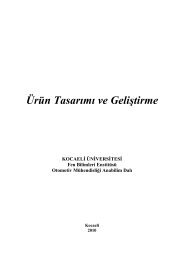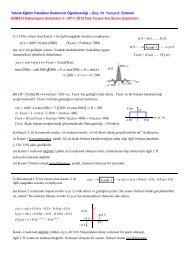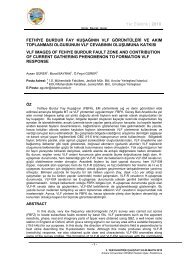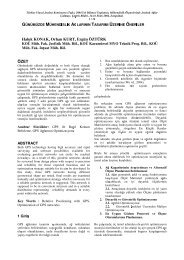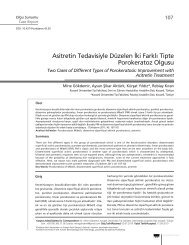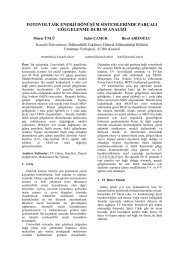Successful treatment of Trichosporon mucoides infection with lipid ...
Successful treatment of Trichosporon mucoides infection with lipid ...
Successful treatment of Trichosporon mucoides infection with lipid ...
Create successful ePaper yourself
Turn your PDF publications into a flip-book with our unique Google optimized e-Paper software.
Letter to the editor<br />
<strong>Successful</strong> <strong>treatment</strong> <strong>of</strong> <strong>Trichosporon</strong> <strong>mucoides</strong> <strong>infection</strong> <strong>with</strong> <strong>lipid</strong><br />
complex amphotericin B and 5-fluorocytosine<br />
Tanil Kendirli, 1 Ergin Ciftçi, 2 Erdal _ Ince, 2 Selim Öncel, 2 Nazan Dalgiç, 2 Haluk Güriz, 3 Emel Unal 4<br />
and Ulker Dogru 2<br />
Divisions <strong>of</strong> 1 Pediatric Intensive Care Unit, 2 Pediatric Infectious Diseases, 3 Pediatric Microbiology Laboratory and 4 Pediatric Oncology, Department <strong>of</strong> Pediatrics,<br />
Ankara University School <strong>of</strong> Medicine, Ankara, Turkey<br />
Summary Infections in immunocompromised children can stem from bacteria, fungi, viruses, or<br />
protozoa, but most importantly, from the host’s endogenous bacterial flora.<br />
Disseminated <strong>infection</strong> caused by <strong>Trichosporon</strong> species is one <strong>of</strong> the emerging mycoses<br />
in neutropenic patients, particularly when they are treated for haematological<br />
malignancy <strong>with</strong> cytotoxic and immunosuppressive chemotherapy. We report a 15year-old<br />
boy <strong>with</strong> acute lymphoblastic leukaemia, whose <strong>Trichosporon</strong> <strong>mucoides</strong> <strong>infection</strong><br />
was successfully treated <strong>with</strong> <strong>lipid</strong> complex amphotericin B plus 5-fluorocytosine.<br />
Key words: <strong>Trichosporon</strong> <strong>mucoides</strong>, sepsis, <strong>lipid</strong> complex amphotericin B, 5-fluorocytosine.<br />
Introduction<br />
The genus <strong>Trichosporon</strong> includes approximately 30<br />
species, at least six <strong>of</strong> which (T. asahii, T. <strong>mucoides</strong>,<br />
T. inkin, T. asteroides, T. cutaneum and T. ovoides) are<br />
associated <strong>with</strong> <strong>infection</strong> (trichosporonosis). 1 The first<br />
two species mentioned are responsible for deep <strong>infection</strong>s<br />
and the last four are involved in superficial<br />
<strong>infection</strong>s, including white piedra. <strong>Trichosporon</strong> asahii,<br />
which is responsible for >90% <strong>of</strong> deep-seated trichosporonoses,<br />
may cause a life-threatening illness. 1–3<br />
These fungi are also normal inhabitants <strong>of</strong> the soil<br />
and are occasionally found in the normal flora <strong>of</strong> the<br />
skin and the mouth. Most patients <strong>with</strong> deep-seated<br />
trichosporonosis have an underlying haematological<br />
malignancy or another neoplasm. Neutropenia as the<br />
result <strong>of</strong> cytotoxic chemotherapy is the most common<br />
apparent risk factor for this <strong>infection</strong>. In immunosuppressed<br />
individuals, <strong>Trichosporon</strong> <strong>infection</strong>s may<br />
disseminate to multiple organs, such as liver, spleen,<br />
lungs and gastrointestinal tract, <strong>of</strong>ten resulting in<br />
death. 3,4 We report a 15-year-old boy <strong>with</strong> acute<br />
Correspondence: Dr Tanil Kendirli, 28. Sok. 31/9, Kazim Orbay, Mah.,<br />
Akdere, 06100 Mamak, Ankara, Turkey.<br />
Tel.: +90 312 3675058. Fax: +90 312 3620581.<br />
E-mail: tanilkendirli@hotmail.com<br />
Accepted for publication 22 December 2005<br />
lymphoblastic leukaemia (ALL), whose deep-seated<br />
<strong>infection</strong> because <strong>of</strong> fluconazole-resistant T. <strong>mucoides</strong><br />
was successfully treated <strong>with</strong> <strong>lipid</strong> complex amphotericin<br />
B plus 5-fluorocytosine.<br />
Case report<br />
The patient was a 15-year-old boy <strong>with</strong> ALL. He had<br />
been given delayed intensification chemotherapy<br />
(L-asparaginase, vincristine, idarubicine, dexamethasone<br />
and cyclophosfamide) 2 weeks previously. While<br />
he was in a good condition, a large thrombus<br />
(25 · 15 mm in size) was detected at the end <strong>of</strong> his<br />
double-lumen catheter. Because the thrombus did not<br />
dissolve <strong>with</strong> thrombolytic therapy, he had surgery.<br />
After the operation, he had a prolonged unconsciousness,<br />
which was possibly related to hypoxia because <strong>of</strong><br />
the obstruction <strong>of</strong> his endotracheal tube owing to<br />
secretion, which has resolved <strong>with</strong>in seconds <strong>with</strong> the<br />
change <strong>of</strong> the tube. Two days later, he was admitted to<br />
our paediatric intensive care unit (PICU) for recurrent<br />
seizures, unconsciousness, respiratory failure and fever.<br />
His pathological signs in the physical examination were<br />
a temperature <strong>of</strong> 39.2 °C, left hemiplegia, absence <strong>of</strong><br />
deep tendon reflexes and bilateral Babinski’s sign.<br />
Laboratory investigation revealed a haemoglobin <strong>of</strong><br />
10.5 g dl )1 , a white blood cell count <strong>of</strong> 3200 ll )1 [88%<br />
polymorphonuclear leucocytes (total granulocyte count:<br />
Ó 2006 The Authors<br />
Journal Compilation Ó 2006 Blackwell Publishing Ltd • Mycoses, 49, 251–253 251
T. Kendirli et al.<br />
1100 ll )1 ), 12% lymphocytes], a platelet count <strong>of</strong><br />
255 000 ll )1 , an erythrocyte sedimentation rate<br />
<strong>of</strong> 67 mm h )1 and a C-reactive protein concentration<br />
<strong>of</strong> 9.7 mg dl )1 . Urinalysis, blood biochemistries, chest<br />
X-ray and echocardiography were normal.<br />
Mechanical ventilation was started. His recurrent<br />
seizures were taken under control <strong>with</strong> diazepam,<br />
phenytoin and midazolam infusion therapy. Meropenem<br />
was initiated for suspected sepsis. After mechanical<br />
ventilation was discontinued on the second day <strong>of</strong> PICU<br />
admission, cranial magnetic resonance imaging<br />
revealed diffuse ischaemic areas.<br />
The patient’s fever persisted. Cracking rales were<br />
detected on the third day <strong>of</strong> meropenem therapy. Chest<br />
X-ray revealed diffuse infiltration in the right lung<br />
(Fig. 1) and right pleural effusion was demonstrated<br />
<strong>with</strong> computed tomography (CT). Despite the addition <strong>of</strong><br />
vancomycin, his pneumonia deteriorated and he had to<br />
be intubated again on the sixth day <strong>of</strong> his admission.<br />
Hypotension, oliguria and cardiac tamponade developed<br />
rapidly. Pericardial effusion showing transudate characteristics<br />
was drained by tube pericardiocentesis;<br />
however, Gram stain and cultures were unrevealing.<br />
Streptokinase was instilled three times into pericardial<br />
space for fibrinoid adhesions. The pericardial fluid<br />
persisted for a 10-day period, at the end <strong>of</strong> which the<br />
drainage tube was pulled out.<br />
Because <strong>of</strong> the prolonged fever, fluconazole<br />
(10 mg kg )1 day )1 ) was initiated on the fifth day <strong>of</strong><br />
hospitalisation. No microorganisms were detected in<br />
tracheal aspirate cultures. Two <strong>of</strong> three blood cultures<br />
were positive for T. <strong>mucoides</strong>. All isolates were identified<br />
by conventional methods including germ tube formation,<br />
morphology on cornmeal Tween-80 agar and Staib agar,<br />
Figure 1 The infiltration at right-low lobe lung on his chest X-ray.<br />
252<br />
Figure 2 The cavitation on right-low lobe lung on thorax<br />
computed tomography.<br />
urease test and biochemical pr<strong>of</strong>ile using the API 20C<br />
AUX and ID 32C system (Bio Merieux, Lyon, France). We<br />
determined antifungal susceptibility to itraconazole,<br />
fluconazole, 5-fluorocytosine and amphotericin B by<br />
ATB FUNGUS 2 (Bio Merieux). Minimal inhibitory<br />
concentrations <strong>of</strong> 5-fluorocytosine and amphotericin B<br />
were 1 and 2 mg l )1 respectively. However, this strain<br />
had a very high minimum inhibitory concentration<br />
(MIC) values for fluconazole (64 mg l )1 ) and itraconazole<br />
(>4 mg l )1 ). Fluconazole <strong>treatment</strong> was discontinued<br />
and <strong>lipid</strong> complex amphotericin B (5 mg kg)1 day )1 )<br />
plus 5-fluorocytosine (100 mg kg )1 day )1 ) were initiated.<br />
The patient’s temperature returned to normal on<br />
the fifth day <strong>of</strong> the new antifungal drug regimen.<br />
Meropenem and vancomycin were discontinued on their<br />
14th day. The pneumonia gradually resolved and the<br />
combination antifungal chemotherapy was continued<br />
for 8 weeks. The patient’s pulmonary findings gradually<br />
improved <strong>with</strong>in 10 days. His fever was taken under<br />
control in 5 days and he was extubated at 11th day <strong>of</strong> his<br />
second intubation. Repeat thorax CT revealed a cavity in<br />
the previously infiltrated area (Fig. 2). The patient was<br />
discharged from the PICU on the 32nd day <strong>of</strong> his<br />
admission. In the follow-up visit 4 months later, his<br />
neurological examination was completely normal.<br />
Discussion<br />
Infections in immunocompromised children can result<br />
from bacteria, fungi, viruses, or protozoa; but most<br />
Ó 2006 The Authors<br />
Journal Compilation Ó 2006 Blackwell Publishing Ltd • Mycoses, 49, 251–253
significant <strong>infection</strong>s are caused by the host’s endogenous<br />
bacterial flora. The most common fungal <strong>infection</strong>s<br />
in children <strong>with</strong> cancer are caused by Candida<br />
species. The fungal pathogens <strong>of</strong> great concern in the<br />
patient <strong>with</strong> neutropenia include Aspergillus, Fusarium,<br />
Mucor, Pseudallescheria and <strong>Trichosporon</strong> species, as these<br />
organisms cause rapidly progressive, extensively<br />
destructive <strong>infection</strong>s. 1,3 Our patient had various features<br />
(haematological malignancy, chemotherapy, mild<br />
neutropenia and open heart operation) that predispose<br />
him to an opportunistic <strong>infection</strong> caused by a fungus,<br />
such as T. <strong>mucoides</strong>. His steroid <strong>treatment</strong> ended<br />
1 month before the onset <strong>of</strong> T. <strong>mucoides</strong> <strong>infection</strong>, and<br />
also dexametasone (8 mg day )1 , for 3 weeks) was given<br />
to him. The duration and nadir <strong>of</strong> his neutropenia were<br />
5 days and 1100 ll )1 respectively.<br />
Disseminated <strong>infection</strong> caused by <strong>Trichosporon</strong> species<br />
is one <strong>of</strong> the emerging mycoses in neutropenic patients,<br />
particularly when they are treated for haematological<br />
malignancy <strong>with</strong> cytotoxic and immunosuppressive<br />
chemotherapy. 3 Disseminated trichosporonosis can be<br />
diagnosed <strong>with</strong> mycological, histopathological or serodiagnostic<br />
tests. However, as <strong>Trichosporon</strong> species frequently<br />
colonise the oral cavity, digestive tract, urinary<br />
tract or the skin; the detection <strong>of</strong> <strong>Trichosporon</strong> species in<br />
sputum or faeces is unreliable. Nonetheless, when a<br />
<strong>Trichosporon</strong> species is detected in an abscess, in pleural<br />
effusion or in normally sterile body fluids such as blood<br />
and spinal fluid, this finding is clinically significant. 3–5<br />
Our patient had clinical sepsis and T. <strong>mucoides</strong> was<br />
isolated in blood. Pneumonia and pericarditis also<br />
developed, but we could not demonstrate T. <strong>mucoides</strong><br />
in pericardial fluid or endotracheal aspirate specimens;<br />
for this reason, pneumonia and pericarditis may be due<br />
to microorganism(s) other than T. <strong>mucoides</strong>. In addition,<br />
pericarditis might stem from immunological processes<br />
such as postpericardiotomy syndrome.<br />
Optimal therapy for serious <strong>Trichosporon</strong> <strong>infection</strong><br />
remains controversial. The outcome <strong>of</strong> the disease <strong>of</strong>ten<br />
depends on the extent <strong>of</strong> the <strong>infection</strong> and the immune<br />
status <strong>of</strong> the host. Many patients <strong>with</strong> pr<strong>of</strong>ound<br />
neutropenia or endocarditis do not respond to any form<br />
<strong>of</strong> therapy. Most patients <strong>with</strong> disseminated <strong>Trichosporon</strong><br />
<strong>infection</strong> have received amphotericin B, sometimes in<br />
combination <strong>with</strong> 5-fluorocytosine. This combination<br />
appears to have limited activity against <strong>Trichosporon</strong><br />
species. There are very limited clinical data regarding<br />
the utility <strong>of</strong> the <strong>lipid</strong> formulations <strong>of</strong> amphotericin B.<br />
Conversely, there is growing experience that supports<br />
azole therapy in <strong>Trichosporon</strong> <strong>infection</strong>s. The most<br />
commonly used fluconazole dosage used was<br />
400 mg day )1 (range: 100–400 mg) for 2–26 weeks.<br />
Mouse models from some clinical reports supported the<br />
superiority <strong>of</strong> fluconazole over amphotericin B for<br />
<strong>treatment</strong> <strong>of</strong> deep-seated <strong>Trichosporon</strong> <strong>infection</strong>s. 2 At<br />
the beginning, we initiated fluconazole for suspected<br />
fungal <strong>infection</strong>; but the T. <strong>mucoides</strong> isolate was resistant<br />
to fluconazole and itraconazole. Finally, we had to<br />
change the antifungal chemotherapy to amphotericin B<br />
and 5-fluorocytosine. Although the optimal duration is<br />
controversial, we have obtained excellent clinical<br />
response to seven weeks <strong>of</strong> 5-fluorocytosine plus amphotericin<br />
B combination.<br />
In conclusion, T. <strong>mucoides</strong> must be considered as an<br />
etiological agent for sepsis and pneumonia in immunocompromised<br />
children. Amphotericin B in combination<br />
<strong>with</strong> 5-fluorocytosine may be a suitable <strong>treatment</strong> for<br />
severe fungal <strong>infection</strong>s; but antifungal susceptibility<br />
should be performed for optimal therapy.<br />
References<br />
<strong>Successful</strong> <strong>treatment</strong> <strong>of</strong> T. <strong>mucoides</strong><br />
1 Ichikawa T, Sugita T, Wang L, Yokoyama K, Nishimura K,<br />
Nishikawa A. Phenotypic switching b-N-acetylhexosamidase<br />
activity <strong>of</strong> the pathogenic yeast <strong>Trichosporon</strong> asahii.<br />
Microbiol Immunol 2004; 48: 237–42.<br />
2 Nettles R, Nichols LS, Bell-McGuinn K, Pipeling MR, Scheel<br />
PJ, Merz WG. <strong>Successful</strong> <strong>treatment</strong> <strong>of</strong> <strong>Trichosporon</strong> <strong>mucoides</strong><br />
<strong>infection</strong> <strong>with</strong> fluconazole in a heart and kidney transplant<br />
recipient. Clin Infect Dis 2003; 36: 63–6.<br />
3 Gokahmetoglu S, Koc AN, Gunes T, Cetin N. Case reports.<br />
<strong>Trichosporon</strong> <strong>mucoides</strong> <strong>infection</strong> in three premature<br />
newborns. Mycoses 2002; 45: 123–5.<br />
4 Piwoz JA, Stadtmauer GJ, Bottone EJ, Weitzman I, Shlasko<br />
E, Cunningham-Rundless C. <strong>Trichosporon</strong> inkin lung<br />
abscesses presenting as a penetrating chest wall mass. Pediatr<br />
Infect Dis J 2000; 19: 1025–7.<br />
5 Singh N, Belen O, Leger M-M, Campos JM. Cluster <strong>of</strong><br />
<strong>Trichosporon</strong> <strong>mucoides</strong> in children associated <strong>with</strong> a faulty<br />
bronchoscope. J Bronchol 2003; 10: 327–8.<br />
Ó 2006 The Authors<br />
Journal Compilation Ó 2006 Blackwell Publishing Ltd • Mycoses, 49, 251–253 253


